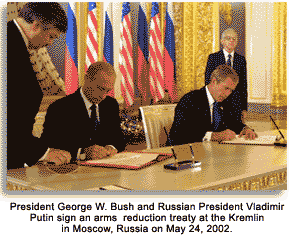The Strategic Arms Reduction Treaty, usually known as START, grew out of negotiations between the United States and the Soviet Union. The START talks began in 1983 to replace the Strategic Arms Limitation Talks, or SALT. After nearly a decade of negotiations, the two nations signed the START I Treaty on July 31, 1991. Soon thereafter, the Soviet Union broke up and the treaty was revised to recognize the existence of former Soviet republics with nuclear capabilities. START I became effective in November 1994. Negotiations to reduce the number of nuclear weapons had already begun. Another treaty, known as START II, was ratified by the United States Senate, but not the Russian Duma. An entirely new treaty, known as the Treaty of Moscow, was signed in 2002. Under that treaty, each side would reduce its nuclear arsenal from about 6,000 weapons to 2,200 by the year 2012.
 START I provided for reductions in the number of strategic offensive arms to equal aggregate levels over a period of seven years. The treaty covers both warheads and delivery systems, such as inter-continental ballistic missiles.
The Lisbon Protocol to the START I Treaty was signed on May 23, 1992, and was orchestrated to accommodate for the breakup of the former Soviet Union. The parties of the treaty were designated as Belarus, Kazakhstan, Russia, and Ukraine, the legal successors of the former Soviet Union. START did not come into force until all of them except Russia had become non-nuclear nations adhering to the Nuclear Non-Proliferation Treaty. After that condition had been met, the parties of START exchanged formal instruments of ratification in Budapest, Hungary, on December 5, 1994.
The second round of talks led to the START II Treaty. President George H.W. Bush and Russian President Boris Yelstin signed the treaty in January 1993, but it did not take effect until START I ended. In September 1994, Yeltsin and President Bill Clinton agreed to begin dismantling their nuclear weapons as soon as the treaty could be ratified by the legislatures for both countries. The U.S. Senate ratified the treaty, but the Russian Duma initially postponed ratification in response to the U.S. and British strikes against Iraq on December 25, 1998 and again on April 2, 1999, because of the NATO bombing against Yugoslavia. The Duma finally ratified the treaty on April 14, 2000.
START I provided for reductions in the number of strategic offensive arms to equal aggregate levels over a period of seven years. The treaty covers both warheads and delivery systems, such as inter-continental ballistic missiles.
The Lisbon Protocol to the START I Treaty was signed on May 23, 1992, and was orchestrated to accommodate for the breakup of the former Soviet Union. The parties of the treaty were designated as Belarus, Kazakhstan, Russia, and Ukraine, the legal successors of the former Soviet Union. START did not come into force until all of them except Russia had become non-nuclear nations adhering to the Nuclear Non-Proliferation Treaty. After that condition had been met, the parties of START exchanged formal instruments of ratification in Budapest, Hungary, on December 5, 1994.
The second round of talks led to the START II Treaty. President George H.W. Bush and Russian President Boris Yelstin signed the treaty in January 1993, but it did not take effect until START I ended. In September 1994, Yeltsin and President Bill Clinton agreed to begin dismantling their nuclear weapons as soon as the treaty could be ratified by the legislatures for both countries. The U.S. Senate ratified the treaty, but the Russian Duma initially postponed ratification in response to the U.S. and British strikes against Iraq on December 25, 1998 and again on April 2, 1999, because of the NATO bombing against Yugoslavia. The Duma finally ratified the treaty on April 14, 2000.
 On May 24, 2002, U.S. President George W. Bush and Russian President Vladimir Putin signed SORT, the Strategic Offensive Reductions Treaty, usually called the Treaty of Moscow. The treaty formalized the understandings reached between the two men at the Washington/Crawford Summit in December 2001. The two countries were allowed to choose the types of weapons they would retain within the agreed limits, and conferences were scheduled to occur twice annually to deal with issues arising from the treaty. The treaty was approved by the U.S. Senate on March 6, 2003, and by the Russian Duma on May 14, 2003.
On May 24, 2002, U.S. President George W. Bush and Russian President Vladimir Putin signed SORT, the Strategic Offensive Reductions Treaty, usually called the Treaty of Moscow. The treaty formalized the understandings reached between the two men at the Washington/Crawford Summit in December 2001. The two countries were allowed to choose the types of weapons they would retain within the agreed limits, and conferences were scheduled to occur twice annually to deal with issues arising from the treaty. The treaty was approved by the U.S. Senate on March 6, 2003, and by the Russian Duma on May 14, 2003.